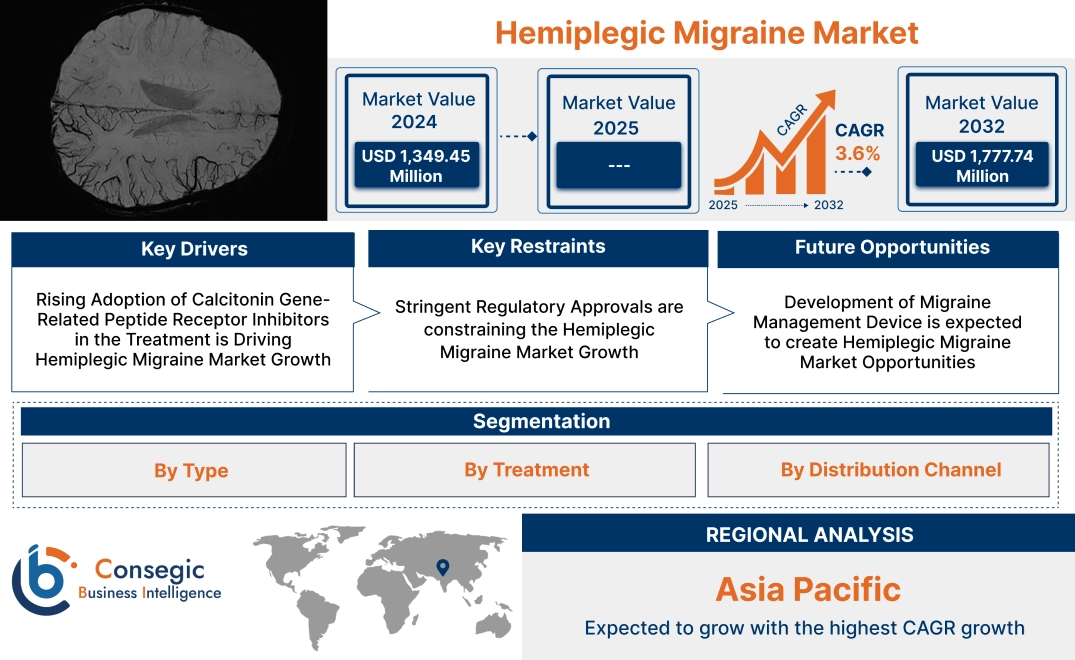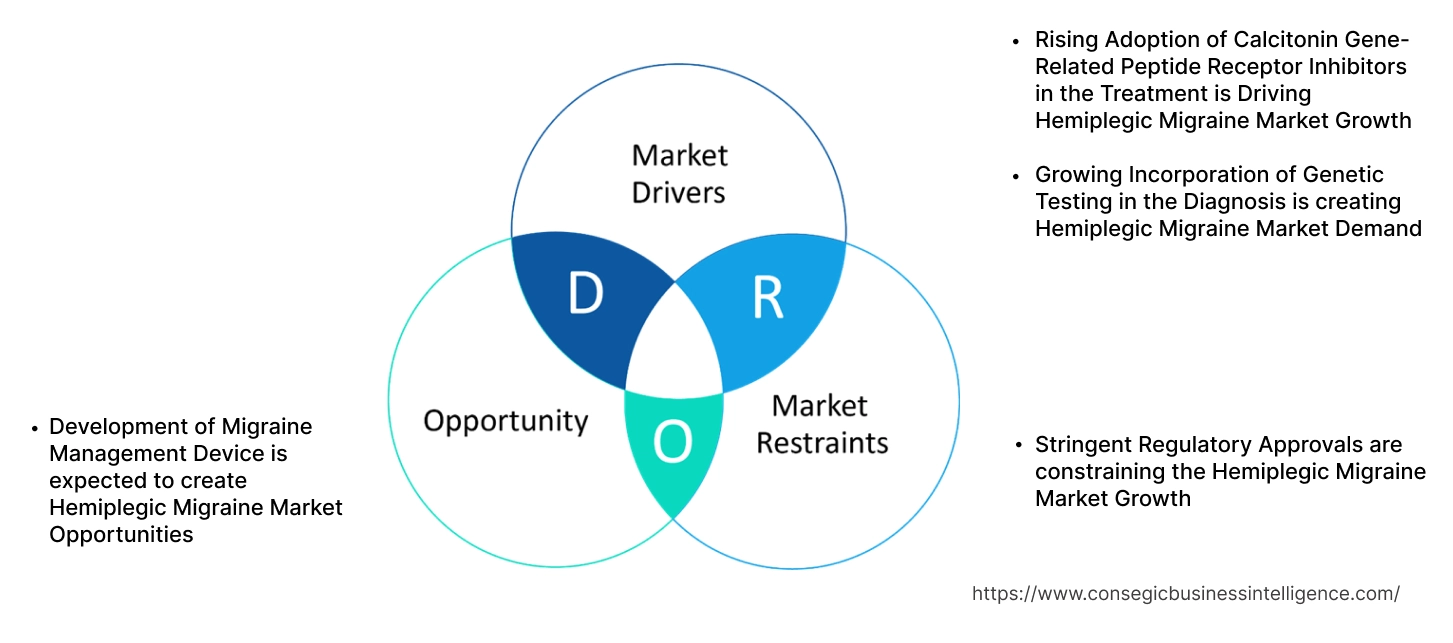- Summary
- Table Of Content
- Methodology
Hemiplegic Migraine Market Size:
Hemiplegic migraine market size is estimated to reach over USD 1,777.74 Million by 2032 from a value of USD 1,349.45 Million in 2024, growing at a CAGR of 3.6% from 2025 to 2032.
Hemiplegic Migraine Market Scope & Overview:
Hemiplegic migraine is subtype of migraine characterized by temporary weakness or paralysis on one side of the body with other migraine symptoms such as severe headaches, nausea, and visual disturbances. It is associated with genetic mutations and will be either familial hemiplegic migraine (FHM) or sporadic hemiplegic migraine (SHM). There are various treatment available for hemiplegic migraine such as triptans, Non-steroidal anti-inflammatory drugs (NSAIDS), calcitonin gene-related peptide(CGRP)s inhibitors, and others. The medication for this migraine is largely distributed through hospital pharmacies, retail pharmacies, drug stores, and online pharmacies. The developments in diagnostic techniques such as genetic testing is further driving the growth in the hemiplegic market.
Key Drivers:
Rising Adoption of Calcitonin Gene-Related Peptide Receptor Inhibitors in the Treatment is Driving Hemiplegic Migraine Market Growth
Calcitonin gene-related peptide receptor inhibitors are a class of drugs that act as antagonists of the calcitonin gene-related peptide receptor. It plays major role in the treatment of hemiplegic migraine by inhibiting inflammation and vasodilation in the brain. These inhibitors are well suited for the patients who do not respond well to the traditional treatments like triptans and have high efficacy with less side effects.
- In 2023, Pfizer launched ZAVZPRET™ (zavegepant), approved by United States Food and Drug Administration (FDA). It is a calcitonin gene-related peptide receptor inhibitor nasal spray used for the acute treatment of hemiplegic migraine.
Thus, rising adoption of calcitonin gene-related peptide receptor inhibitors in the acute treatment is leading to market demand by reducing side effects and improving migraine condition in the patients.
Growing Incorporation of Genetic Testing in the Diagnosis is creating Hemiplegic Migraine Market Demand
Genetic testing is a type of medical test that identifies changes in genes, chromosomes, the genome, or proteins. It helps to identify migraine, especially familial hemiplegic migraine which is caused due to the genetic mutations in the genes like CACA1A, ATP1A2, and SCN1A. Genetic testing utilizes next-generation sequencing to detect single nucleotide and copy number variants in genes associated with hemiplegic migraine.
- In 2023, Quest Diagnostics launched consumer-initiated genetic test which is available through the company's consumer health business. It is called as Genetic Insights which is powered by advanced next-generation sequencing technology, which analyzes thousands of DNA variants in genes associated with hemiplegic migraine.
Thus, growing incorporation of genetic testing is leading to hemiplegic migraine market demand though early detection of the disease in the patient.
Key Restraints:
Stringent Regulatory Approvals are constraining the Hemiplegic Migraine Market Growth
Regulatory approvals are significant restrain in the market demand due to stringent requirements for the approval of new drugs and therapies. The lengthy and complex approval processes for new medications delays the introduction of innovative treatments, limiting treatment options for patients. Regulatory agencies like United States Food and Drug Administration, European Medicines Agency, and others require extensive clinical trials and data before granting approval to the medications, which is time-consuming and costly. Additionally, some countries in low-income region such as Africa face problems with regulatory frameworks, resulting in delays in drug availability or inconsistent access to approved treatments.
Thus, regulatory approvals are constraining hemiplegic migraine market expansion by increasing the time and expense needed to bring treatment to the patients.
Future Opportunities :
Development of Migraine Management Device is expected to create Hemiplegic Migraine Market Opportunities
A migraine management device is a medical device designed to alleviate or prevent migraines by modulating nerve activity through non-invasive or minimally invasive techniques such as electrical, magnetic or thermal stimulation. This device offers an innovative alternative to the hemiplegic migraine patients who prefers non-drug treatments or those who experience adverse effects from medications.
- In 2024, Reddy's Laboratories Ltd launched drug-free migraine management device Nerivio® in Europe. It is a drug-free wearable device that uses Remote Electrical Neuromodulation (REN) mechanism to specifically activate conditioned pain modulation by stimulating nerve endings in hemiplegic migraine patients.
Thus, development of migraine management device is expected to create hemiplegic migraine market opportunities through acute and preventive treatment.
Hemiplegic Migraine Market Segmental Analysis :
By Type:
By type, the market is divided into familial hemiplegic migraine and sporadic hemiplegic migraine.
Trends in Type:
- According to hemiplegic migraine market trends, early detection of familial hemiplegic migraine is possible due to the availability of genetic testing.
- Sporadic hemiplegic migraine is growing significantly in the market due to rising awareness among the patients as per market trends.
The familial hemiplegic migraine accounted for the largest market share in the year 2024.
- Familial hemiplegic migraine is a genetic subtype of migraine characterized by temporary motor weakness or paralysis on one side of the body and is inherited in autosomal dominant pattern.
- It has strong genetic association with the mutations in the genes like CACA1A, ATP1A2, and SCN1A.
- FHM is more prevalent than sporadic hemiplegic migraine because of its hereditary nature, which makes it easier to identify though family history.
- Further rising investment in genetic testing have made the diagnosis of the familial hemiplegic migraine in the early stages.
- For instance, in 2024, iMeUsWe launched genetic testing services in partnership with MapMyGenome. It helps to identify familial hemiplegic migraine patients in the early stages through DNA testing and providing free genetic counselling to the patients.
- Thus, familial hemiplegic migraine is dominating in the market due to advancement in diagnosis leading to early detection of the disease in the patients.
The sporadic hemiplegic migraine is expected to grow at the fastest CAGR over the forecast period.
- Sporadic hemiplegic migraine is a genetic subtype of migraine characterized by temporary motor weakness or paralysis on one side of the body during migraine attacks, without the family history of the condition.
- It typically results from spontaneous genetic mutations rather than hereditary factors.
- SHM is rising in the market due to advancement in diagnostic tools and imaging techniques, improving its detection.
- The rising awareness among healthcare professionals about hemiplegic migraine is contributing to the growth of sporadic hemiplegic migraine.
- Thus, sporadic hemiplegic migraine is growing significantly in the market due to rising awareness and advancement in screening techniques such as genetic testing.
By Treatment:
By treatment, the market is divided into triptans, NSAIDS, calcitonin gene-related peptide inhibitors, and others.
Trends in Treatment:
- As per hemiplegic migraine market trends, triptans are widely used in the treatment due to their rapid onset of action and immediate headache relief.
- Adoption of calcitonin gene-related peptide receptor inhibitors is growing in the treatment due to fewer side effects and reduction in migraine frequency as per market trends.
The triptans accounted for the largest market share in the year 2024.
- Triptans are a class of drugs used to treat acute migraine attacks by acting on serotonin receptors in the brain to reduce inflammation, constrict blood vessels, and block pain signals.
- It is widely used in the treatment of hemiplegic migraine due to their rapid onset of action and high efficacy in reliving migraine symptoms.
- It helps to provide relief from headache and other neurological symptoms such as tremors and seizures in the patients.
- Triptans such as sumatriptan and rizatriptan are especially beneficial for patients with moderate to severe hemiplegic migraine.
- Thus, triptans are widely used for the treatment of hemiplegic migraine due to their high efficacy and immediate relief from headache in the patients.
The calcitonin gene-related peptide receptor inhibitors is expected to grow at the fastest CAGR over the forecast period.
- Calcitonin gene-related peptide receptor inhibitors are a class of drugs that act as antagonists of the calcitonin gene-related peptide receptor.
- It plays major role in the treatment of hemiplegic migraine by inhibiting inflammation and vasodilation in the brain.
- Calcitonin gene-related peptide receptor inhibitors are effective in reducing migraine frequency with fewer side effects in the patients.
- Further, companies are investing in the development of these inhibitors contributing to the specialized and effective treatment.
- For instance, in 2021, AbbVie launched QULIPTA™ (atogepant) approved by United States Food and Drug Administration. It is the first and only oral calcitonin gene-related peptide receptor inhibitors specifically developed for the preventive treatment of migraines including hemiplegic migraine.
- Thus, incorporation of calcitonin gene-related peptide receptor inhibitors is rising in the treatment of hemiplegic migraine due to its fewer side effects and efficacy in reducing migraine frequency.
By Distribution Channel:
By distribution channel, the market is divided into hospital pharmacies, retail pharmacies, drug stores, and online pharmacies.
Trends in Distribution Channel:
- As per market trends, hospitals plays major role in the distribution of sumatriptan and erenumab drugs providing easy accessibility to the patients.
- Adoption of online pharmacies is rising in the market due to direct and wider accessibility to medications as per market trends.
The hospital pharmacies accounted for the largest market share of 44.81% in the year 2024.
- A hospital pharmacy is a department within a hospital that prepares, compounds, stocks and dispenses inpatient medications.
- Hospital pharmacies play a crucial role in the distribution of hemiplegic migraine treatment ensuring access to essential drugs for patients.
- They facilitate access to the treatment for the patients diagnosed within the hospital settings, offering both in-patient and out-patient services.
- Hospital pharmacies collaborate with governments and non-profit organizations to distribute free or subsidized medication therapies to reduce the burden of migraine patients.
- They play an integral part in the hemiplegic migraine treatment within large hospitals and neurological patient units due to their large distribution of drugs.
- Thus, hospital pharmacies are widely used in the market due to their effective distribution and easy access to the hemiplegic migraine patients.
The online pharmacies are expected to grow at the fastest CAGR over the forecast period.
- Online pharmacies refer to digital platforms that allow customers to purchase medications and health-related products via the internet.
- In the distribution of hemiplegic migraine treatment, adoption of online pharmacies is rising due to convenience, lower prices of drugs and quick access to medications.
- Online pharmacies include direct-to-consumer services, telemedicine consultation, and delivery of prescribed medications for hemiplegic migraine
- Further, expanding online pharmacies market in countries is driving the market demand in terms of distribution.
- For instance, in 2023, according to India Brand Equity Foundation, the online pharmacies market in India is expected to increase at a compounded annual rate of 44% by the year 2025. Online pharmacies distribute the drugs such as sumatriptan, zavegepant, and others which are used in the treatment of hemiplegic migraine.
- Thus, adoption of online pharmacies is growing in the distribution of drugs for hemiplegic migraine treatment due to their convenience and direct-to-consumer services.
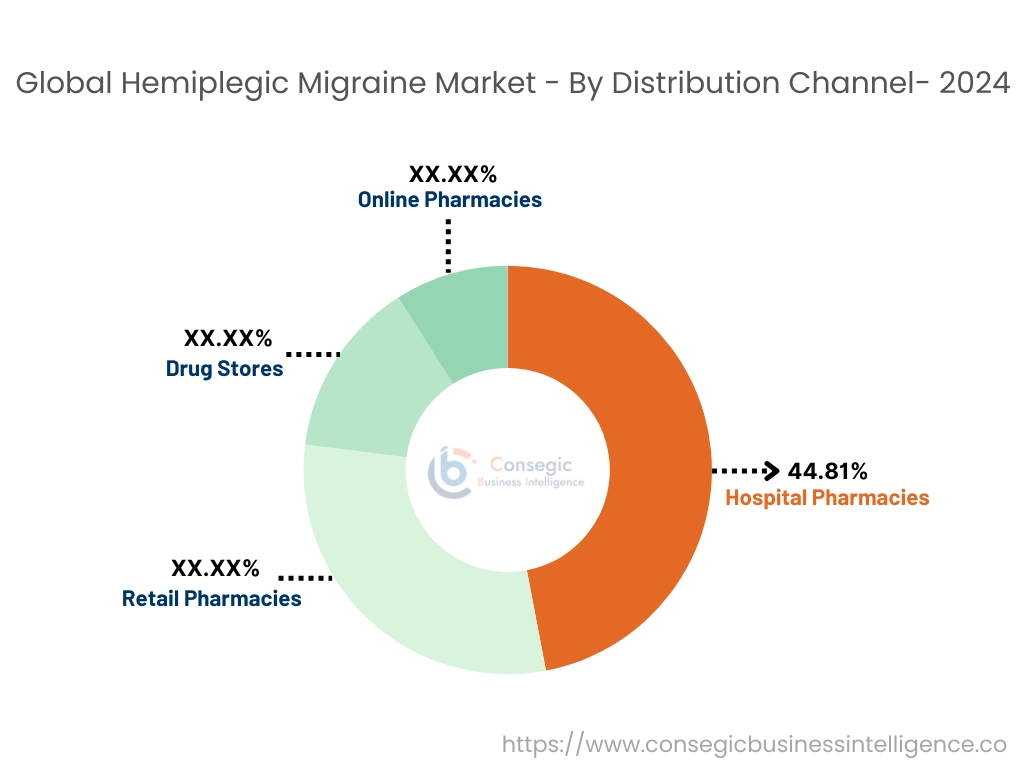
Regional Analysis:
The regional segment includes North America, Europe, Asia Pacific, the Middle East and Africa, and Latin America.
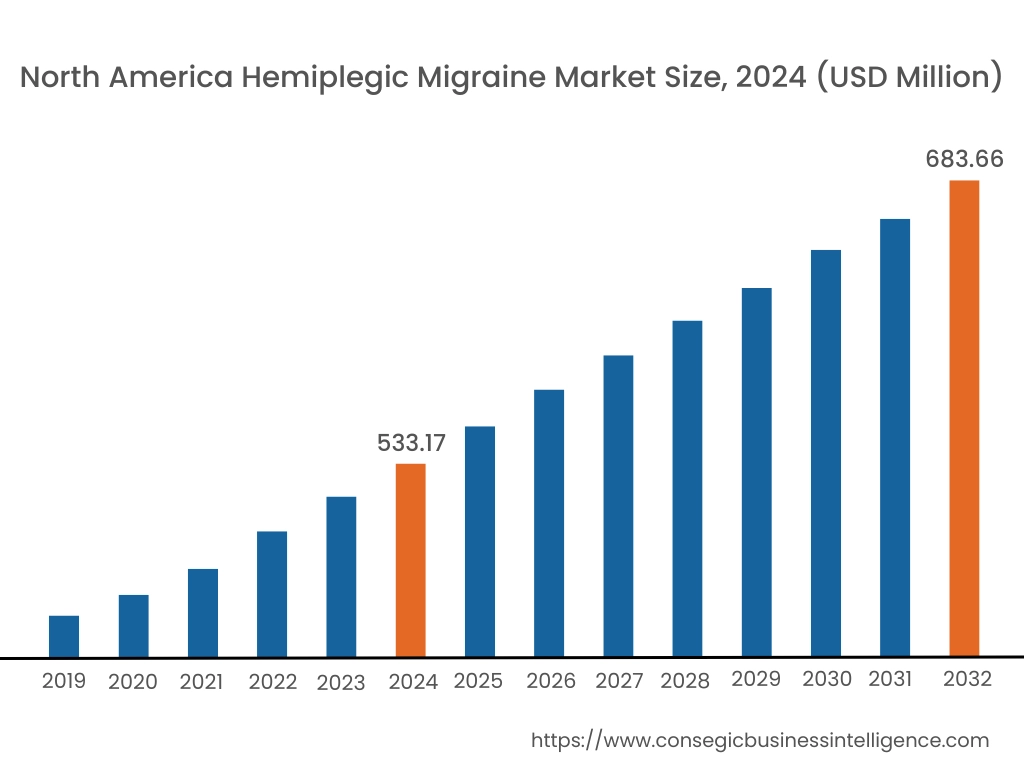
In 2024, North America accounted for the highest market share at 39.51% and was valued at USD 533.17 Million and is expected to reach USD 683.66 Million in 2032. In North America, United States accounted for the highest market share of 72.13% during the base year of 2024.
The hemiplegic migraine market share of North America is significant due to well-established healthcare infrastructure and rising government initiatives. The region benefits form advanced healthcare technology and growing adoption of telemedicine services. Governments and non-profit organizations such as Centers for Disease Control & Prevention and World Health Organization is raising awareness and providing CGRP inhibitors medications to the hemiplegic migraine patients. Moreover, companies in this region are investing in the migraine tracking program to improve daily life and minimizing symptoms in the patients.
- In 2024, Evidation launched MigraineSmart, a health engagement experience and symptom tracking program on the on the Evidation app. It helps hemiplegic migraine individuals track and better understand their migraine symptoms.
Thus, North America is leading in the market due to rising government investments and growing adoption of digital healthcare services as per market analysis.
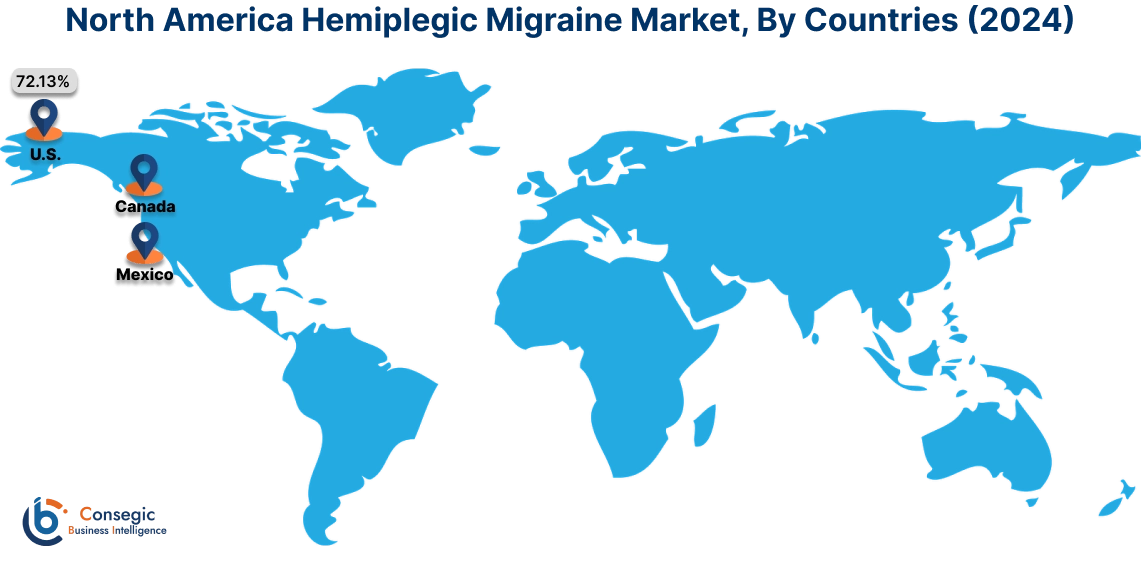
Asia-pacific is expected to witness the fastest CAGR of 4.2% over the forecast period of during 2025-2032.
As per hemiplegic migraine market analysis, the Asia-pacific region is experiencing rapid growth in the market fueled by expanding healthcare systems, growing awareness and an increasing availability of genetic testing. Countries like China, India and Japan are investing significantly in healthcare infrastructure and with rising economic developments, more patients are getting access to diagnostic and treatment options. Additionally, collaborations between public and private sectors are supporting research in rare diseases leading to drug developments in the healthcare industry. Additionally, the advancement in healthcare technology and improved accessibility in both rural and urban areas is expanding the market.
Thus, hemiplegic migraine market share of Asia-Pacific is expanding due to rising economic developments and improved healthcare infrastructure as per market analysis.
According to hemiplegic migraine market analysis, Europe region is experiencing steady growth in the market driven by high prevalence of patients and strong awareness programs that promote early diagnosis and treatment. Europe’ s robust healthcare system enables better access to diagnostic and treatment options, including advanced medications like calcitonin gene-related peptide receptor inhibitors. Online pharmacies and digital health platforms in the region are playing important role in making hemiplegic migraine treatment accessible, particularly for patients in remote areas or with mobility issues. Research and developments in the region are focused on improving drug formulations and reducing side effects associated with long-term use of calcitonin gene-related peptide receptor inhibitors.
The Middle East and Africa region is experiencing gradual growth in the market, driven by increasing awareness of rare diseases and gradual improvements in healthcare infrastructure. Although diagnostic access remains limited in some areas, governments and private health organizations are gradually investing in rare disease programs, facilitating patient diagnosis and treatment support. The online pharmacy industry has emerged as a key distributor channel in the region, helping address barriers like limited healthcare access in remote areas. Further, enhanced government initiatives, increased collaboration with international organizations, and telemedicine advancements is further accelerating hemiplegic migraine market expansion in the region as per analysis.
As per market analysis, the hemiplegic migraine market in the Latin America is driven by rising government initiatives and improving healthcare access. Countries like Brazil, Mexico and Argentina are major contributors in the market due to growing awareness and advanced diagnosis in the patients. The rise of online pharmacies and digital health platforms has significantly impacted the distribution of medications making it more accessible, especially in remote areas. Government initiatives and partnerships with international health organization are helping improve diagnosis and treatment availability. The development of diagnostic facilities, collaboration between government and non-profit organizations is gradually enhancing patient access to specialized migraine care.
Top Key Players and Market Share Insights:
The hemiplegic migraine industry is highly competitive with major players providing products to the national and international markets. Key players are adopting several strategies in research and development (R&D) and product innovation to hold a strong position in the global hemiplegic migraine market. Key players in the hemiplegic migraine industry include-
- Pfizer Inc. (United States)
- AstraZeneca (United Kingdom)
- Johnson & Johnson (United States)
- Merck & Co. (United States)
- Endo International Plc (United States)
- Reddy’s Laboratories Ltd. (United States)
- AbbVie Inc. (United States)
- GlaxoSmithKline Plc (United Kingdom)
- Impax Laboratories (United States)
- Eli Lily and Company (United States)
Recent Industry Developments :
Launches:
- In 2024, Lundbeck launched "Say Yep" campaign for migraine drug in the United States. It helps to reach migraine patients, including hemiplegic migraine.
Partnerships and Collaborations:
- In 2024, Axsome Therapeutics partnered with the American Migraine Foundation. It helps raise awareness of hemiplegic migraine patient needs during migraine & headache awareness month in the June.
Hemiplegic Migraine Market Report Insights :
| Report Attributes | Report Details |
| Study Timeline | 2019-2032 |
| Market Size in 2032 | USD 1,777.74 Million |
| CAGR (2025-2032) | 3.6% |
| By Type |
|
| By Treatment |
|
| By Distribution Channel |
|
| By Region |
|
| Key Players |
|
| North America | U.S. Canada Mexico |
| Europe | U.K. Germany France Spain Italy Russia Benelux Rest of Europe |
| APAC | China South Korea Japan India Australia ASEAN Rest of Asia-Pacific |
| Middle East and Africa | GCC Turkey South Africa Rest of MEA |
| LATAM | Brazil Argentina Chile Rest of LATAM |
| Report Coverage |
|
Key Questions Answered in the Report
How big is the hemiplegic migraine market? +
In 2024, the hemiplegic migraine market is USD 1,349.45 million.
Which is the fastest-growing region in the hemiplegic migraine market? +
Asia-Pacific is the fastest-growing region in the hemiplegic migraine market.
What specific segmentation details are covered in the hemiplegic migraine market? +
Type, treatment, and distribution channel are covered in the hemiplegic migraine market.
Who are the major players in the hemiplegic migraine market? +
Pfizer Inc. (United States), AstraZeneca (United Kingdom) and Dr. Reddy’s Laboratories Ltd. (United States) are some of the major players in the market.
